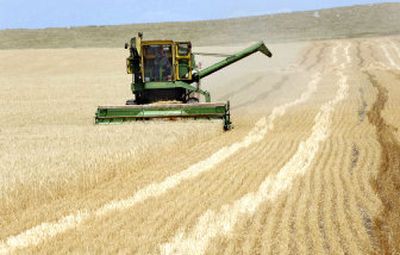Ongoing drought raises concerns in Dakotas

STEELE, N.D. – Fields of wheat, durum and barley in the Dakotas this dry summer will never end up as pasta, bread or beer. What is left of the stifled crops has been salvaged to feed livestock struggling on pastures where hot winds blow clouds of dirt from dried-out ponds.
Some ranchers have been forced to sell their entire herds, and others are either moving their cattle to greener pastures or buying more already-costly feed. Hundreds of acres of grasslands have been blackened by fires sparked by lightning or farm equipment.
“These 100-degree days for weeks steady have been burning everything up,” said Steele Mayor Walter Johnson, who added that he’d prefer two feet of snow over this weather.
Farm ponds and other small bodies of water have dried out from the heat, leaving the residual alkali dust to be whipped up by the wind. The blowing dirt-and-salt mixture is a phenomenon that hasn’t been seen in south central North Dakota since the Dust Bowl of the 1930s, Johnson said.
More than 60 percent of the United States now has abnormally dry or drought conditions, stretching from Georgia to Arizona and across the North through the Dakotas, Minnesota, Montana and Wisconsin, said Mark Svoboda, a climatologist for the National Drought Mitigation Center at the University of Nebraska at Lincoln.
An area stretching from south central North Dakota to central South Dakota is the most drought-stricken region in the nation, Svoboda said.
“It’s the epicenter,” he said. “It’s just like a wasteland in north central South Dakota.”
Conditions aren’t much better a little farther north. Paul Smokov and his wife, Betty, raise several hundred cattle on their 1,750-acre ranch north of Steele, a town of about 760 people.
North Dakota’s all-time high temperature was set here in July 1936, at 121. Smokov, now 81, remembers that time and believes conditions this summer probably are worse.
“I could see this coming in May,” Smokov said of the parched pastures and wilted crops. “That’s the time the good Lord gives us our general rains. But we never got them this year.”
Brad Rippey, a federal Agriculture Department meteorologist in Washington, said this year’s drought is continuing one that started in the late 1990s. “The 1999 to 2006 drought ranks only behind the 1930s and the 1950s. It’s the third-worst drought on record – period,” Rippey said.
Herman Schumacher, who owns Herreid Livestock Auction in north central South Dakota, said his company is handling more sales than ever because of the drought.
In May, June and July last year, his company sold 3,800 cattle. During the same months this year, more than 27,000 cattle have been sold, he said.
“I’ve been in the barn here for 25 years and I can’t even compare this year to any other year,” Schumacher said.
He said about 50 ranchers have run cows through his auction this year.
“Some of them just trimmed off their herds, but about a third of them were complete dispersions – they’ll never be back,” he said.
North Dakota State University professor and researcher Larry Leistritz said it’s too early to tell what effect this year’s drought will have on commodity prices. Flour prices already have gone up and may rise more because of the effect of drought on wheat.
Eventually, more than farmers could suffer.
“Agriculture is not only the biggest industry in the state, it’s just about the only industry,” Leistritz said. “Communities live or die with the fortunes of agriculture.”
Susie White, who runs the Lone Steer motel and restaurant in Steele, along Interstate 94, said even out-of-state travelers notice the drought.
“Even I never paid attention to the crops around here. But I notice them now because they’re not there,” she said.
“We’re all wondering how we’re going to stay alive this winter if the farmers don’t make any money this summer,” she said.